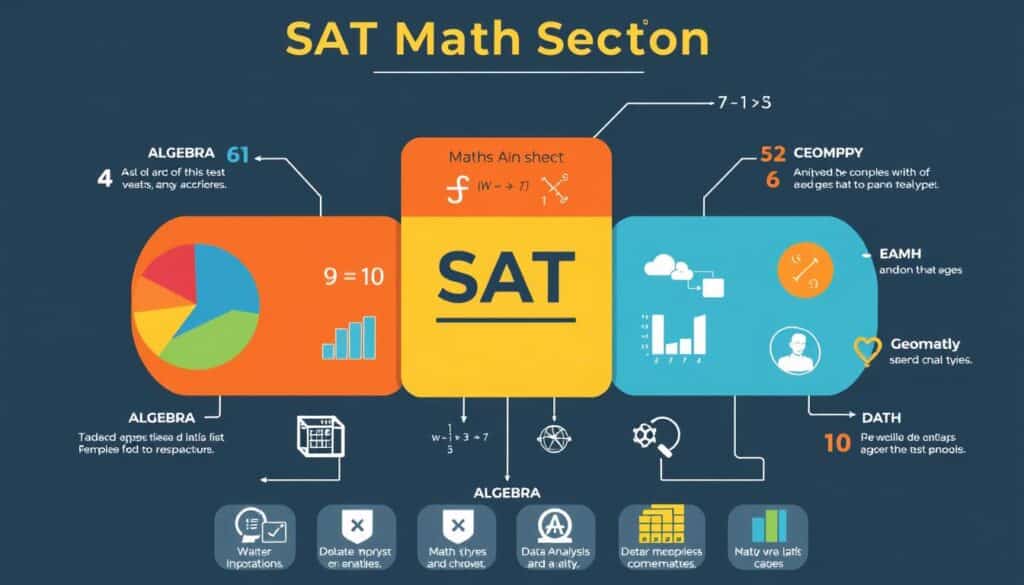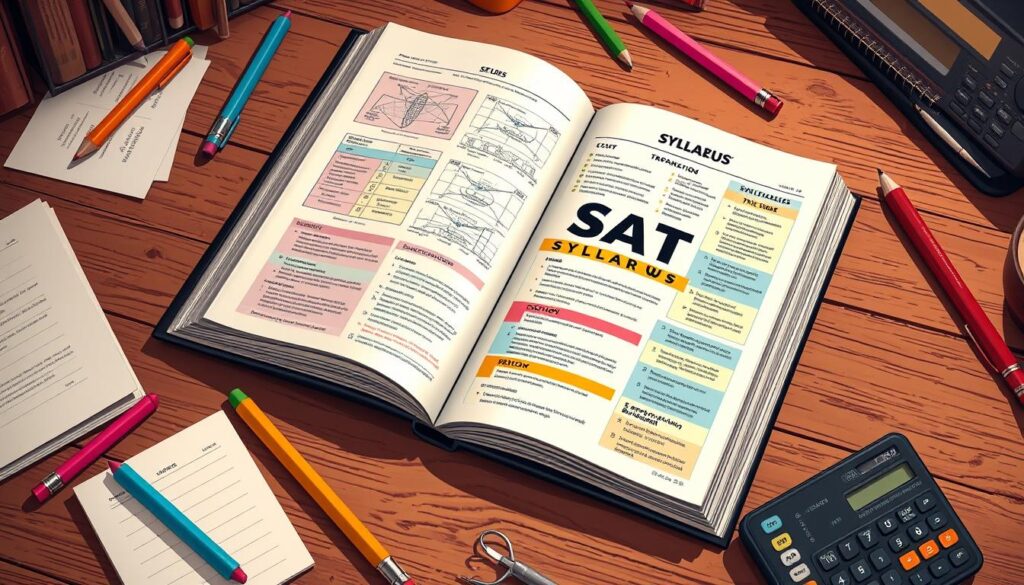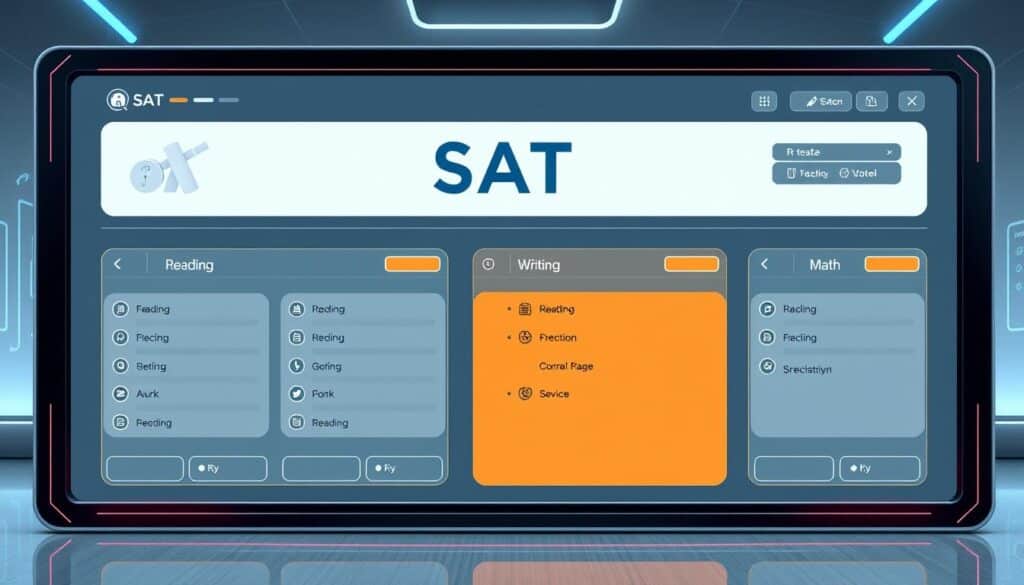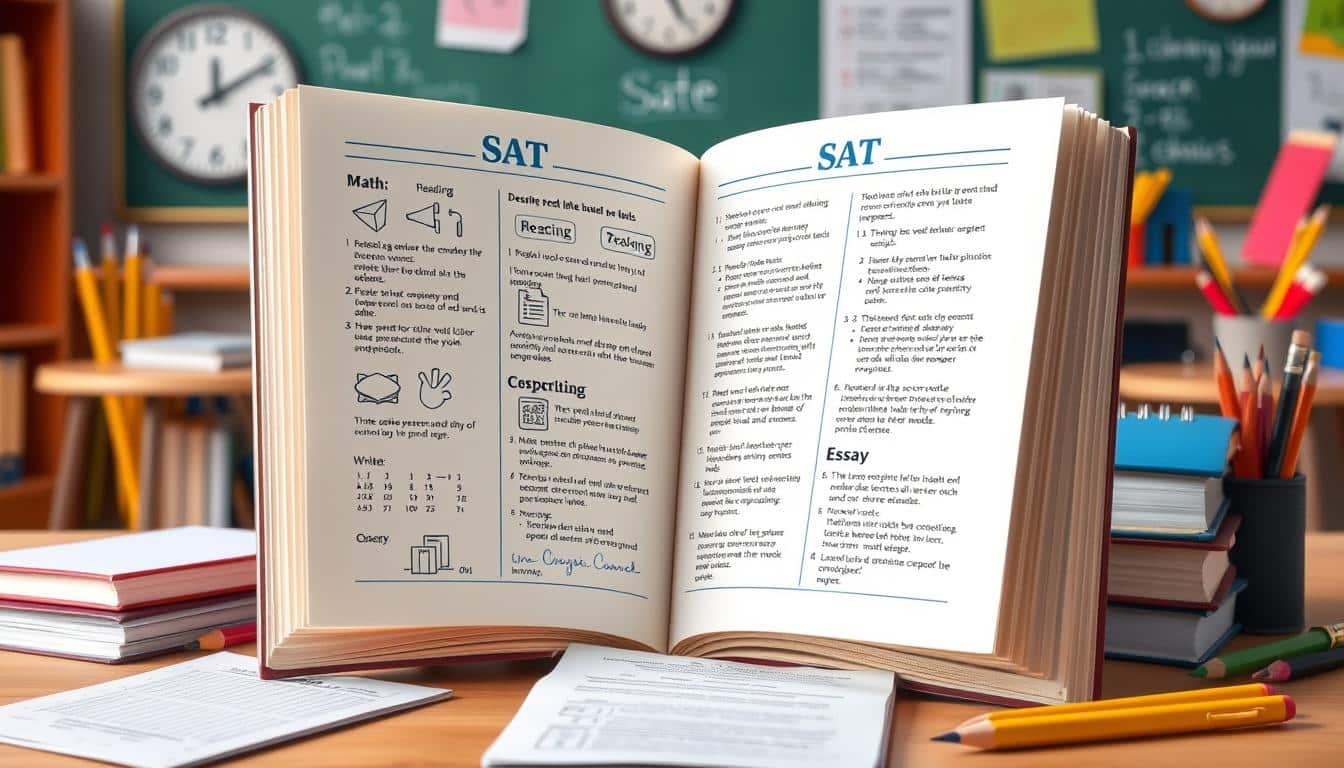The new Digital SAT exam is coming in 2024. It’s a big change in college admissions testing. The Digital SAT has a new format and syllabus. It aims to give a better look at what students know and can do.
The Digital SAT has two main parts: Reading and Writing, and Math. The Reading and Writing section has 54 questions and takes 64 minutes. The Math section has 44 questions and takes 70 minutes. This means students get more time to answer each question than before.
The syllabus covers many subjects like literature, history, and science. Reading passages come from the U.S. and around the world. The Writing and Language section tests grammar and how well students express ideas. It has 44 multiple-choice questions in 35 minutes.
Key Takeaways
- The Digital SAT is divided into two main sections: Reading and Writing, and Math.
- The Reading and Writing section includes 54 questions and is allotted 64 minutes, while the Math section consists of 44 questions and 70 minutes.
- The Digital SAT syllabus covers a range of topics, including literature, history, social sciences, and science.
- The Writing and Language section assesses students’ grammar, usage, and expression of ideas through 44 multiple-choice questions.
- The Digital SAT provides 43% more time per question compared to the old SAT and 68% more time than the ACT.
Breaking Down the SAT Sections
The SAT exam has three main parts: Reading, Writing and Language, and Math. Knowing what each section needs is key to doing well on the test.
How to Master SAT Reading
The SAT Reading section tests your ability to understand and analyze different types of texts. To do well, focus on improving your reading skills. Practice with various texts and learn to spot main ideas, supporting details, and the author’s tone quickly.
Managing your time well is also important. Practice reading fast while still answering questions correctly.
Tips for Excelling at SAT Writing and Language
The SAT Writing and Language section checks your grammar, sentence structure, and writing skills. Annotating passages helps you see important parts like transitions and word choice. Knowing common mistakes can also help you edit better.
| SAT Section | Time | Number of Questions | Question Types |
|---|---|---|---|
| Reading | 64 minutes | 54 | Multiple-choice |
| Writing and Language | 35 minutes | 44 | Multiple-choice |
| Math | 70 minutes | 44 | 75% Multiple-choice, 25% Grid-in |
Understanding each SAT section helps you create better study plans. This way, you can improve your score on this critical test.
Conquering SAT Math

The SAT Math section is a key part of the exam. It covers topics like algebra, geometry, and data analysis. To do well, students need a good strategy that includes understanding concepts, solving problems, and managing time.
How-To Approach the Math Section
The SAT Math section has two parts. The first is 25 minutes without a calculator, and the second is 55 minutes with a calculator. Knowing the format and content of each part helps students perform better. The no-calculator section focuses on algebra and problem-solving. The calculator section covers more advanced topics like data analysis and advanced math.
Practicing regularly is essential for mastering SAT Math. Students should practice different types of questions, focusing on their weak areas. It’s also important to stay calm and focused during the exam. Being able to quickly identify key words, visualize problems, and solve them step by step can greatly improve scores.
Factors to Consider for Difficult Math Questions
When tackling tough math questions, students should take a step-by-step approach. First, they should read the question carefully, identify key information, and understand the concepts. Using scratch paper to work through problems can help avoid getting stuck. It’s also crucial to manage time well and not spend too much time on one question. The SAT Math section tests a wide range of skills in a short time.
| SAT Math Section Details | No Calculator | Calculator | Total |
|---|---|---|---|
| Number of Questions | 20 (15 multiple choice, 5 grid-ins) | 38 (30 multiple choice, 8 grid-ins) | 58 |
| Time Allocated | 25 minutes | 55 minutes | 80 minutes |
By understanding the SAT Math section, developing strategies, and practicing, students can improve their skills. This will help them feel more confident and prepared for this challenging part of the exam.
Preparing for the SAT Essay

The SAT essay section is a unique challenge for students. It requires them to write a well-structured and insightful essay. This essay should show their critical thinking and writing skills.
How to Craft a High-Scoring Essay
The first step is to clearly state a thesis or central argument in the introduction. This sets the tone for the entire essay. It gives the reader a clear understanding of the student’s perspective.
In the body paragraphs, students should provide strong supporting evidence and analysis. Relevant examples and a thorough examination of how they support the thesis are crucial.
Effective time management and organization are also key for success on the SAT essay. Students should plan their essay before starting to write. Then, they should stick to a well-structured outline to ensure they cover all necessary points.
In the conclusion, students should restate their thesis and summarize the main arguments made throughout the essay.
Finally, reviewing the essay for any grammatical errors or areas where clarity can be improved is recommended. Taking the time to polish the essay can make a significant difference in the final score.
“The SAT essay is an opportunity for students to showcase their analytical and writing skills. By focusing on a clear thesis, compelling evidence, and effective organization, students can craft an essay that leaves a lasting impression on the graders.”
With dedicated practice and a strategic approach, students can develop the skills necessary to excel on the SAT essay section. They can achieve their desired score.
SAT Syllabus

The SAT syllabus outlines what topics and skills are tested on the SAT exam. It has three main sections: Reading, Writing and Language, and Math. The SAT Reading section tests your ability to understand and analyze texts. The SAT Writing and Language section checks your grammar and writing skills. The SAT Math section has both calculator and no-calculator parts, covering algebra, geometry, and data analysis.
The SAT exam has two main parts: Reading/Writing and Mathematics. The Reading section has 5 passages with 11 questions each. The Writing section has 4 passages with 11 questions each. The Math section has 58 questions, with 20 without a calculator and 38 with one. The whole test takes 3 hours and 50 minutes.
Knowing the SAT syllabus is key to preparing well for the exam. It helps you aim for a good SAT score. The SAT test gives raw scores for reading, writing, and math. These scores are then scaled to a total score of 1600.
| SAT Test Section | Number of Questions | Duration |
|---|---|---|
| Reading | 52 multiple-choice questions in 5 passages | 65 minutes |
| Writing and Language | 44 questions (4 passages) | 35 minutes |
| Math | 58 questions (20 no-calculator, 38 calculator) | 80 minutes |
| Total | 154 questions | 180 minutes |
The optional essay section was dropped from the general SAT test in 2021. But it’s still available in some USA school districts. The essay used to take 50 minutes to complete and should be around 650-700 words.
The new Digital SAT 2024 will be shorter, lasting 2 hours and 14 minutes. The Reading and Writing section will take 64 minutes, and Math will take 70 minutes. The Digital SAT will use Multistage Adaptive Testing for a more personalized test experience.
Strategies for SAT Success

To do well on the SAT, you need a good study plan. Break down the exam into parts and set aside time for each. This helps you study evenly. Taking practice tests often is key to see how you’re doing and what you need to work on.
How to Create an Effective Study Plan
A good SAT study plan has a few important parts:
- Comprehensive coverage – Make sure you cover all topics, like reading, writing, and math.
- Consistent practice– Study regularly, even if it’s just for a little while. This helps you remember things better and get better at taking tests.
- Targeted practice tests – Take full-length practice tests to see how you do. This helps you find out what you’re good at and what you need to work on.
- Timely adjustments – Keep checking how you’re doing and change your study plan if needed. This helps you keep getting better.
Factors That Affect Your SAT Score
Many things can affect how well you do on the SAT, including:
- Time management – Use your time wisely during the test to answer as many questions as you can.
- Test anxiety – Use relaxation techniques and mindfulness to help manage stress during the test.
- Preparation – Good preparation, like practicing a lot and knowing the material well, is key to a high score.
- Test-taking strategies – Use smart strategies, like quickly looking over questions and doing the easy ones first, to do better.
- Focus and concentration – Stay focused and concentrated during the test to get the best results.
By managing your time well, handling stress, preparing thoroughly, using smart test-taking strategies, and staying focused, you can improve your SAT score. This will help you succeed.
The Digital SAT Structure

The Digital SAT marks a big change in college entrance exams. It’s all about the digital world, making tests easier and more tailored for students. Let’s explore what makes the Digital SAT unique take the sat sat syllabus 2024 sat preparation section of the sat exam sat exam syllabus and pattern sat reading and writing section sat reading and writing section sat exam 2024.
Sections and Modules
The Digital SAT has two main parts: Reading and Writing, and Math. Each part is split into two modules. These modules adjust the test’s difficulty based on how well you do.
- The Reading and Writing section has 54 questions. It includes 25 questions that count and 2 that don’t in each module.
- The Math section has 44 questions. It includes 20 questions that count and 2 that don’t in each module.
Adaptive Approach
The Digital SAT’s adaptive feature is a big plus. The first part of each section has questions of different levels. Then, the second part is customized to fit your skills, making the test more personal.
Tools and Features
The Digital SAT comes with tools to help you during the test. You’ll find the Option Eliminator, Calculator, and Reference Sheet. These tools aim to make the test easier and more manageable.
Knowing the Digital SAT’s setup and how it adapts can help you prepare better. It’s all about getting ready and using your time wisely to do well.
| Section | Number of Questions | Time Limit |
|---|---|---|
| Reading and Writing | 54 | 64 minutes |
| Math | 44 | 70 minutes |
| Total | 98 | 2 hours 14 minutes |
The Digital SAT is made to give a more personal and efficient test experience. It uses adaptive modules and tools to really get to know what you know and can do.
Also Read : TOEFL Syllabus Insights: Tips For Success On The Exam
Conclusion
Understanding the SAT syllabus and its parts helps students feel ready for the exam. They can use this knowledge to make a strong study plan. This plan focuses on the Reading, Writing and Language, and Math sections.
Learning how to write a great essay and manage study time is also key. Knowing the SAT format helps students do well. With practice and a good plan, students can do their best on the exam.
Using the tips from this article, students can get ready for the SAT exam well. They can reach their goals and get a good SAT score. This score can lead to many opportunities in education and careers.
FAQs
Q: What is the SAT exam syllabus for 2024?
A: The SAT exam syllabus for 2024 includes sections on reading, writing, and mathematics. Each section is designed to assess skills necessary for college readiness and success. The exam pattern has also been updated to align with the new digital SAT format.
Q: How does the SAT exam pattern differ in 2024?
A: The SAT exam pattern 2024 introduces a digital format, which changes the way questions are presented and answered. The total time for the exam remains similar, but the structure of the sections may vary slightly, focusing on more integrated and real-world applications of knowledge.
Q: What can I expect from the reading and writing section of the SAT?
A: The reading and writing section of the SAT includes questions related to standard English conventions, such as grammar and sentence structure, as well as comprehension of written passages. This section is designed to evaluate your ability to analyze and interpret texts.
Q: What topics are covered in the SAT math section?
A: The math syllabus for the SAT includes algebra, problem-solving, data analysis, and advanced math concepts. Students should be prepared to tackle a variety of mathematical problems that apply these concepts in practical scenarios.
Q: How can students prepare for the SAT exam syllabus 2024?
A: To prepare for the SAT exam syllabus 2024, students should utilize official SAT practice materials, take practice tests, and review the content outlined in the syllabus. Engaging in SAT prep courses can also help reinforce key concepts and strategies.
Q: Are there any changes in the writing section of the SAT for 2024?
A: Yes, the writing section of the SAT has been updated to better reflect the skills needed in college and career settings. Students will still be assessed on their ability to write clearly and effectively, focusing on standard English conventions and effective communication.
Q: What is the difference between the SAT general test and the SAT subject test?
A: The SAT general test assesses a student’s overall readiness for college, covering broad content areas. In contrast, SAT subject tests focus on specific subjects, allowing students to demonstrate their knowledge and skills in particular academic areas. However, as of 2021, the College Board has discontinued SAT subject tests.
Q: What is the significance of the digital SAT exam syllabus?
A: The digital SAT exam syllabus is significant because it reflects the evolving nature of assessments in education. The digital format allows for more interactive types of questions and immediate feedback, which can enhance the testing experience and provide a more accurate measure of a student’s abilities.
Q: Is there a specific SAT exam syllabus for medical students?
A: While there is no separate SAT exam syllabus for medical students, those planning to pursue medical fields should focus on achieving high scores in the math and reading sections, as these skills are essential for success in medical school admissions tests.
